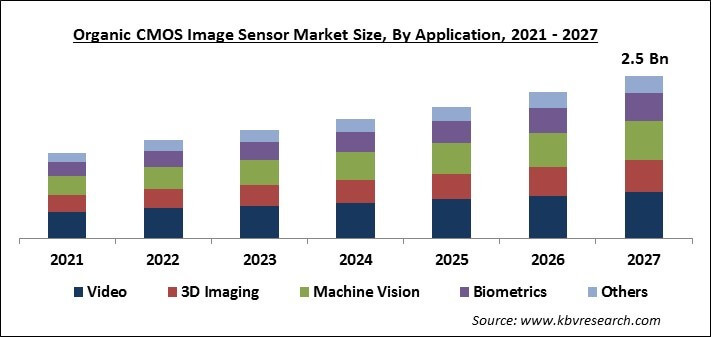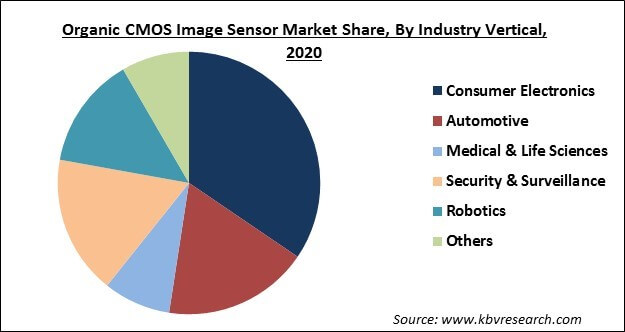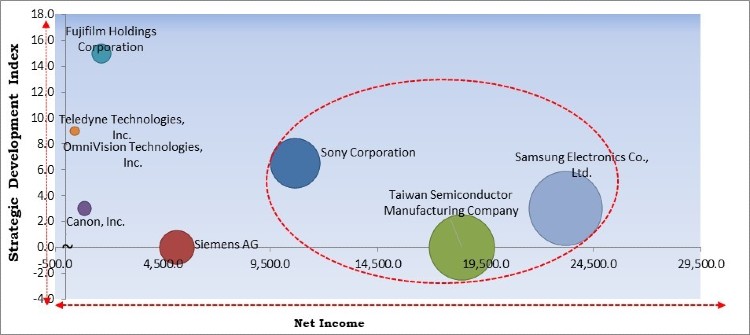The Global Organic CMOS Image Sensor Market size is expected to reach $2.5 billion by 2027, rising at a market growth of 11.3% CAGR during the forecast period. The organic CMOS image sensor refers to the improved technology of the image sensor that includes features like broad dynamic range along with high sensitivity, which makes it possible to take a clear image with more realistic colors and rich in textures even in a low-light setup. This type of image sensor utilizes an organic photoelectric conversion layer with an extraordinary photoelectric conversion feature that offers better performance than any other traditional image sensor by surging the number of pixels and offering better high-resolution images.
There are many features offered by organic CMOS image sensors like improved color contrast and high image quality, which would accelerate the growth of the organic CMOS image sensor market during the forecast period. Additionally, the emergence of various technologies like global shutter technology is anticipated to increase the adoption of organic CMOS image sensors in the market. Though, the fast drain of the battery by these image sensors in comparison to the traditional image sensors would hamper the growth of the organic CMOS image sensor market. However, the high dependency on these sensors for a wide range of applications and rapid & cheap processing ways would augment the market growth during the forecast period.

The global COVID-19 pandemic has impacted almost every domain of society, especially the electronics & semiconductor market. Business & manufacturing units in several nations were closed due to the imposed lockdown as the number of COVID-19 cases was constantly increasing. The fight against pandemic is still on and thus, it would have a significant impact on various sections of society. Moreover, the partial or complete lockdown has affected the global supply chain, thus creating more challenges for manufactures to reach out to their customers. The whole production process has been adversely impacted by the pandemic.
This pandemic has created many uncertainties in the market across the globe. In addition, disruption in the manufacturing process of the various region has also negatively impacted the demand for the organic CMOS sensor market. Thus, the global COVID-19 pandemic is estimated to hinder the growth of the market during the forecast period.
Based on Image Processing, the market is segmented into 2D Sensor and 3D Sensor. The 2D sensors segment obtained the highest revenue share of the organic CMOS image sensor market in 2020. The 2D organic CMOS image sensors offer high performance in several applications that include medical & life sciences, logistics, machine vision & automation, and robotics. Thus, a 2D sensor has acquired the highest growth rate by image processing category. In addition, this sensor has a high speed of operation, with a shutter type feature, high resolution, and raised dynamic range (DB).
Based on Array Type, the market is segmented into Linear Image Sensors and Area Image Sensors. The liner image sensor market segment would procure the biggest share in the organic CMOS image sensor market during the forecast period. This linear image sensor refers to an optical image element, which changes the optical image into an analogue signal. This type of sensors is mostly used in various applications like image scanner, copy scanning components, scan camera, reader bar code, and grain color sorting.

Based on Application, the market is segmented into Video, 3D Imaging, Machine Vision, Biometrics, and Others. The organic CMOS technology has enhanced over the last few years and would fulfill the demands of modern formats such as 4K videos and improved image processing roles, which depends on the benefit of CMOS's digital existence.
For example, OmniVision's latest 64MP image sensor comes with 0.8m pixels in a 1/1.7-inch format. To capture still images and 4K video output, these sensors include type-2 with 22 microlens phase detection autofocus. The latest CMOS image sensors assist in ensuring that the video is clear at high resolutions or when the object moves frequently, it is very important for high-quality surveillance video. Such image sensors are widely utilized in IP security cameras and video surveillance systems.
Based on Industry Vertical, the market is segmented into Consumer Electronics, Automotive, Medical & Life Sciences, Security & Surveillance, Robotics and Others. The consumer electronics market segment is anticipated to dominate the market during the forecast period, which is followed by the automotive vertical. The growing usage of cameras including image sensors in smartphones across the globe that provides various advantages to the consumer electronics sector. The rising popularity of smartphone photography is motivating smartphone makers to use organic image sensors with an aim to attract more customers.
| Report Attribute | Details |
|---|---|
| Market size value in 2020 | USD 1.1 Billion |
| Market size forecast in 2027 | USD 2.5 Billion |
| Base Year | 2020 |
| Historical Period | 2017 to 2019 |
| Forecast Period | 2021 to 2027 |
| Revenue Growth Rate | CAGR of 11.3% from 2021 to 2027 |
| Number of Pages | 292 |
| Number of Tables | 473 |
| Report coverage | Market Trends, Revenue Estimation and Forecast, Segmentation Analysis, Regional and Country Breakdown, Competitive Landscape, Companies Strategic Developments, Company Profiling |
| Segments covered | Image Processing, Array Type, Application, Industry Vertical, Region |
| Country scope | US, Canada, Mexico, Germany, UK, France, Russia, Spain, Italy, China, Japan, India, South Korea, Singapore, Taiwan, Brazil, Argentina, UAE, Saudi Arabia, South Africa, Nigeria |
| Growth Drivers |
|
| Restraints |
|
Based on Regions, the market is segmented into North America, Europe, Asia Pacific, and Latin America, Middle East & Africa. Asia Pacific region emerged as the leading region in the organic CMOS image sensor market due to the growing demand for consumer electronics products and swift development in the medical & life sciences industry in this region. Additionally, Asia-Pacific is anticipated to record a substantial growth rate over the forecast period. With the availability of low-cost labor and the presence of various manufacturing facilities by several global companies like Toshiba Corporation, Samsung Electronics, Xiaomi Corporation, Taiwan Semiconductor Manufacturing, Sony Corporation, and Panasonic Corporation, the organic CMOS image sensor market would improve the productivity in this region.

Free Valuable Insights: Global Organic CMOS Image Sensor Market size to reach USD 2.5 Billion by 2027
The major strategies followed by the market participants are Product Launches. Based on the Analysis presented in the Cardinal matrix; Samsung Electronics Co., Ltd., Taiwan Semiconductor Manufacturing Company, and Samsung Electronics Co., Ltd. are the major forerunners in the Organic CMOS Image Sensor Market. Companies such as Fujifilm Holdings Corporation, Teledyne Technologies, Inc., and Canon, Inc. are some of the key innovators in the market.
The market research report covers the analysis of key stake holders of the market. Key companies profiled in the report include Canon, Inc., Fujifilm Holdings Corporation, Sony Corporation, Siemens AG, Samsung Electronics Co., Ltd. (Samsung Group), Teledyne Technologies, Inc., Xenics NV, OmniVision Technologies, Inc., Taiwan Semiconductor Manufacturing Company, and AMS AG.
By Image Processing
By Array Type
By Application
By End User
By Geography
The organic CMOS image market size is projected to reach USD 2.5 billion by 2027.
The rising implementation of high-resolution cameras embedded with image sensors in mobile devices are driving the market in coming years, however, Fast drainage of battery in organic CMOS image sensors have limited the growth of the market.
Canon, Inc., Fujifilm Holdings Corporation, Sony Corporation, Siemens AG, Samsung Electronics Co., Ltd. (Samsung Group), Teledyne Technologies, Inc., Xenics NV, OmniVision Technologies, Inc., Taiwan Semiconductor Manufacturing Company, and AMS AG.
The expected CAGR of the organic CMOS image market is 11.3% from 2021 to 2027.
Disruption in the manufacturing process of the various region has also negatively impacted the demand for the organic CMOS sensor market. Thus, the global COVID-19 pandemic is estimated to hinder the growth of the market during the forecast period.
Our team of dedicated experts can provide you with attractive expansion opportunities for your business.

